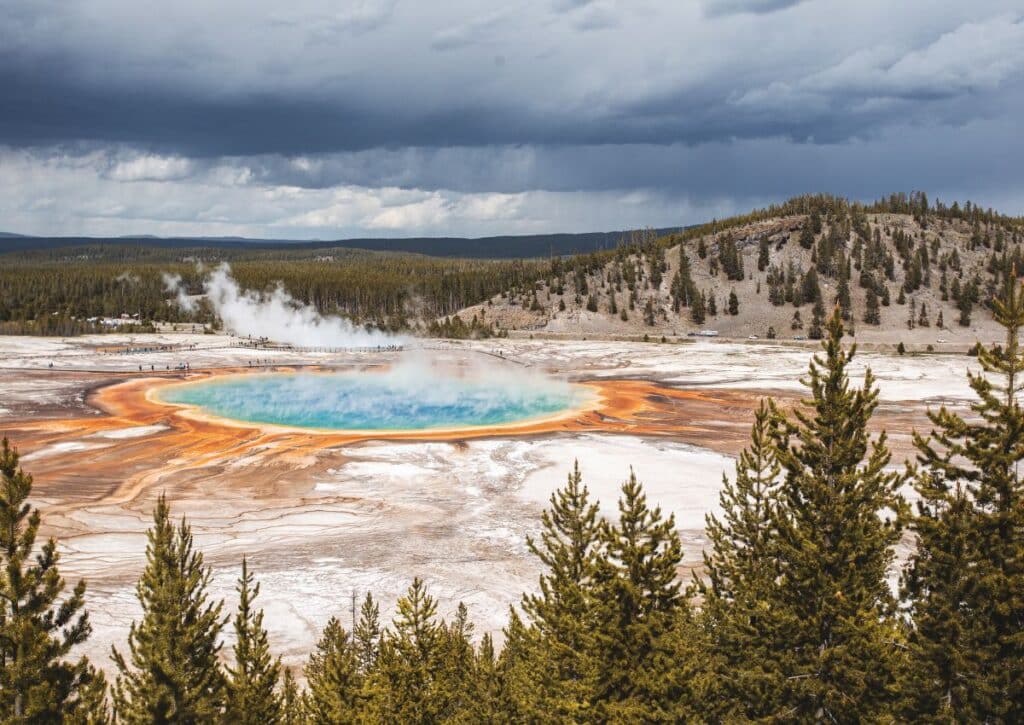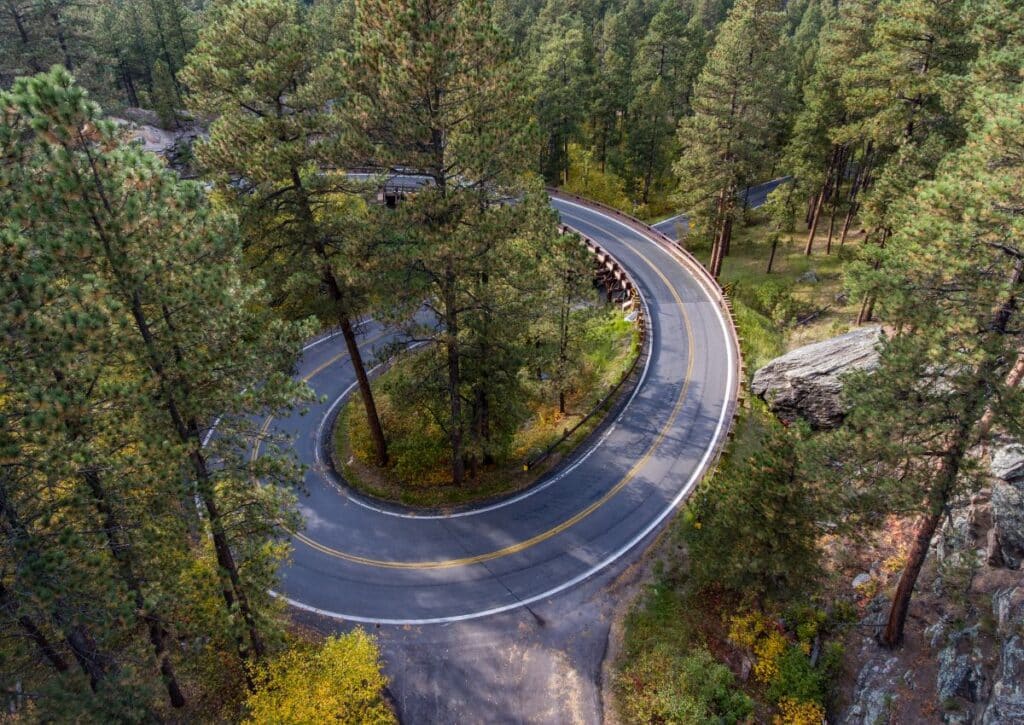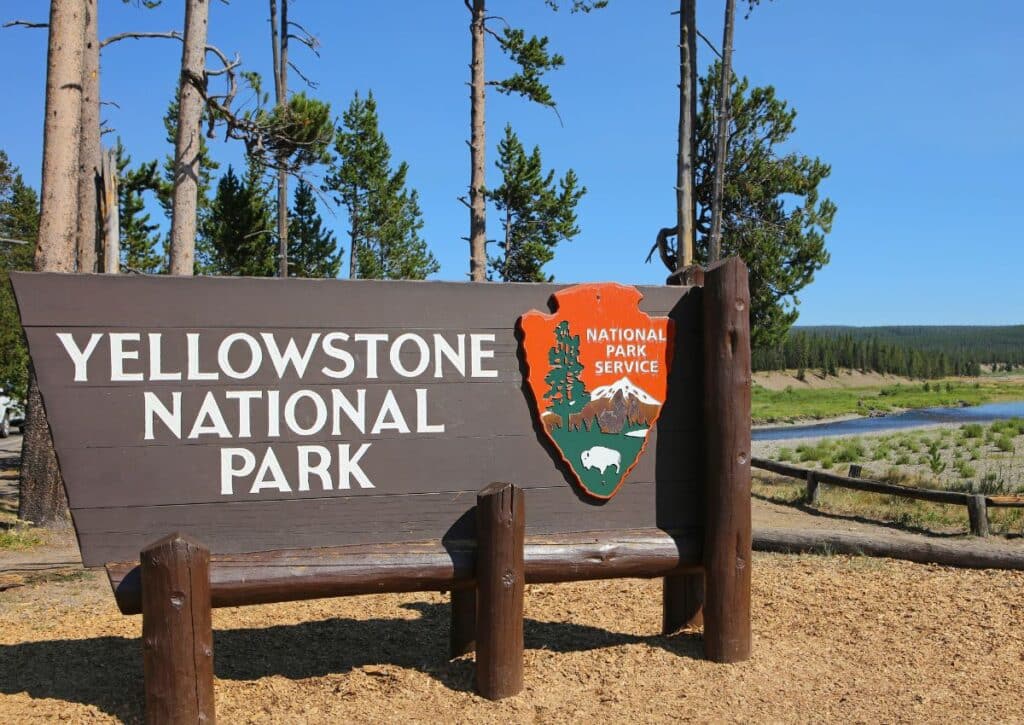Discover the geothermal wonders of Hot Springs of Yellowstone National Park: from Grand Prismatic to Old Faithful. Dive into a guide of 17 favorites!
Curious about the geothermal wonders that make Hot Springs Yellowstone National Park a world-renowned attraction? Sitting atop a volcanic hotspot, this park boasts an array of spectacular geysers and hot springs.
It’s a marvel of nature where heat from deep within the earth powers stunning displays of steam and boiling water, while painting a vibrant palette of colors on the surface.
From the famed Grand Prismatic Spring to the reliable Old Faithful, these natural phenomena draw visitors from all over the globe. So join us as we explore these magnificent hot springs and unearth the secrets that lie beneath Yellowstone.
Grand Prismatic Spring
Interested in understanding what makes the Hot Springs in Yellowstone National Park so extraordinary? One of the crown jewels of the park, capturing imaginations of visitors worldwide, is the Grand Prismatic Spring.
This spring is the largest in the United States and the third-largest globally, spanning over 370 feet in diameter. But its size is not the only impressive aspect.
The Grand Prismatic Spring is renowned for its mesmerizing rainbow-like color display, a spectacle that lends the spring its distinctive name.
This kaleidoscope of colors is due to thermophilic (heat-loving) microorganisms flourishing in the mineral-rich waters, creating a canvas of deep blue, vibrant green, fiery orange, and bold red hues depending on the temperature and nutrient conditions.
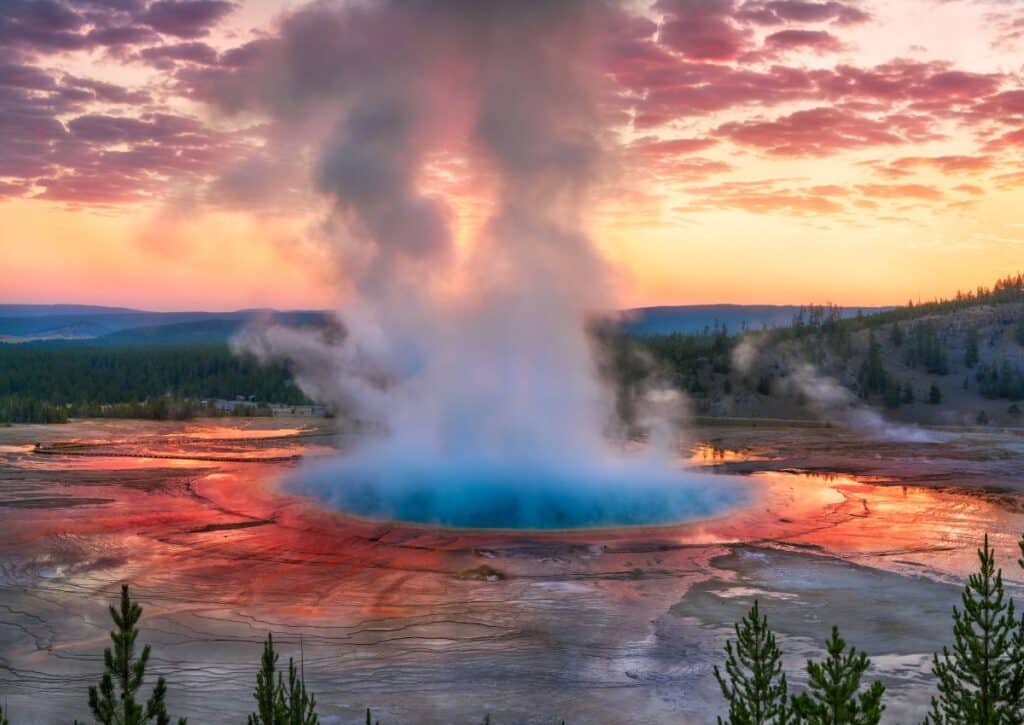
What is often regarded as a natural artwork is, in fact, a manifestation of complex geothermal activity. Heated by the volcanic magma beneath, the spring water reaches a scalding temperature of approximately 160 degrees Fahrenheit.
As the boiling water surfaces, it cools and spreads out in concentric rings, creating a stratified thermal and nutrient environment. This allows different thermophiles to dominate in separate rings of color, showcasing the remarkable biodiversity that can thrive in such extreme conditions.
The best place to witness this breathtaking sight is from the Grand Prismatic Spring Overlook, which provides an elevated view of the entire spring and its colorful expanses. Whether it’s your first time visiting or a regular stop on your Yellowstone journey, the Grand Prismatic Spring is a spectacle of nature’s power, beauty, and adaptability, making it a must-see in the park.
This is just the start, so strap in as we delve deeper into the geothermal wonders of Yellowstone National Park.
The Old Faithful
Named in 1870 during the Washburn-Langford-Doane Expedition, Old Faithful is one of the most predictable geysers on earth. It’s renowned for its powerful eruptions, which occur roughly every 44 to 125 minutes, shooting steaming water up to 185 feet high.
This remarkable predictability is due to the geyser’s stable underground plumbing system, unimpeded by rocks or debris, making Old Faithful a marvel of geological precision.
Each eruption can last between 1.5 to 5 minutes, and the spectacle attracts millions of visitors annually. It’s an embodiment of nature’s power, consistency, and mystery, bringing to life the deep geothermal activity that characterizes Yellowstone National Park.
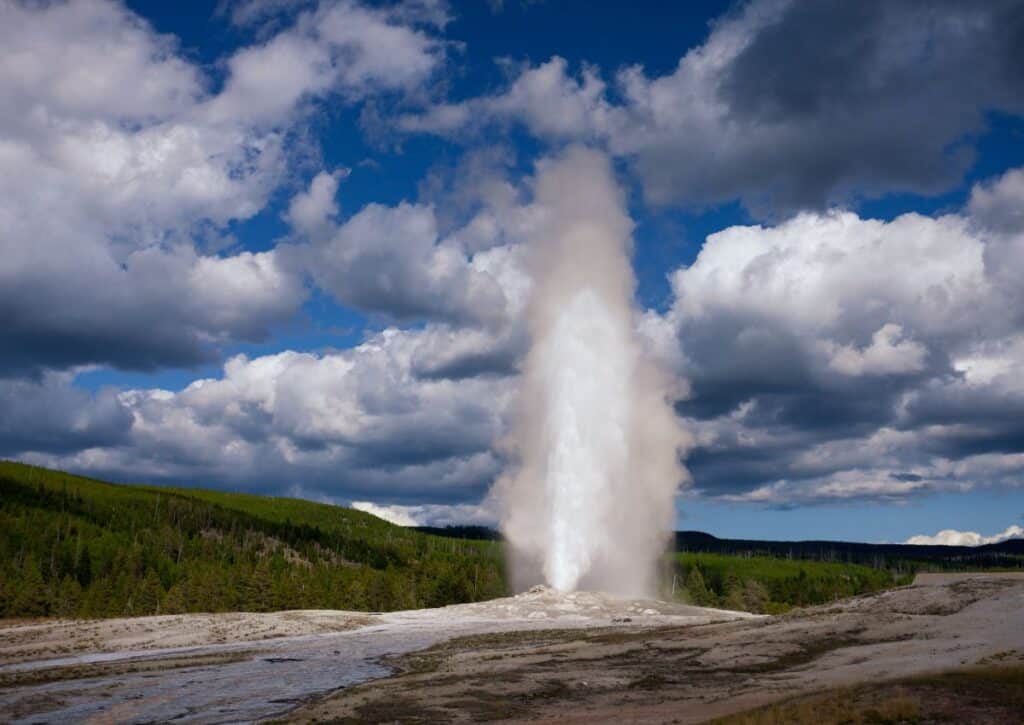
In addition to its geologic significance, Old Faithful serves as a symbol for the park’s conservation efforts, emphasizing the importance of preserving these natural wonders for future generations. Old Faithful continues to awe, becoming an unforgettable part of every Yellowstone visitor’s experience.
Upper Geyser Basin
The Upper Geyser Basin, located in the southwestern section of Yellowstone National Park, is an iconic hotspot for geothermal activity, boasting the highest concentration of geysers in the world. One of the park’s most visited areas, it features over 150 geothermal wonders sprawled across two square miles. The heart of the basin is the Old Faithful area, home to the renowned Old Faithful geyser and the Old Faithful Inn, one of the park’s architectural treasures.
Exploring the area, you’ll traverse an extensive network of boardwalk trails, looping around vibrant hot springs, erupting geysers, and bubbling fumaroles.
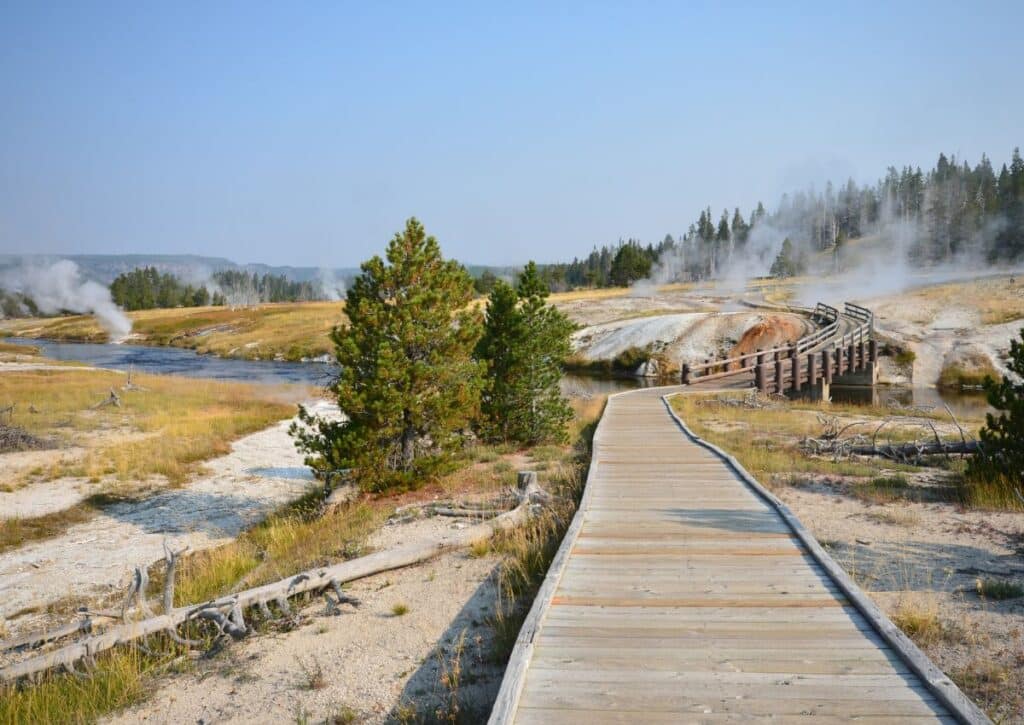
The most popular route is the Geyser Hill loop, starting from the Old Faithful, passing by numerous geysers including the Castle Geyser, known for its large sinter deposits, and the Riverside Geyser, famous for its predictable and stunning eruptions that often create a rainbow in the spray.
Among the fascinating facts about this area is that many geysers here have predictable eruption patterns, making it a thrilling spectacle for visitors who can plan to witness these spectacular eruptions. Remember that Yellowstone’s geysers are not theme park attractions, and their activity can vary, but being able to predict these eruptions to an extent is a unique feature of the park’s geysers, especially in the Upper Geyser Basin.
If you want to dig deeper into the geothermal wonders of the park, the Old Faithful Visitor Education Center offers exhibits on hydrothermal features, life in extreme environments, volcanic geology, and cultural history. Don’t miss the geyser prediction window, where you can get the prediction times for the next eruption of Old Faithful and five other geysers.
The Upper Geyser Basin is a vibrant, living testament to Yellowstone’s volcanic underpinnings, where you can witness nature’s drama unfolding right at your feet.
Mammoth Hot Springs
Nestled in the northern edge of Yellowstone National Park, Mammoth Hot Springs presents an ethereal landscape like no other.
This geothermal region, unique among Yellowstone’s geothermal areas, is renowned for its dramatic terraces made up of layers of carbonate deposits left by the flow of hot water from the springs.
The terraces, reminiscent of natural staircases, look as though they’ve been carved by an artist’s hand.
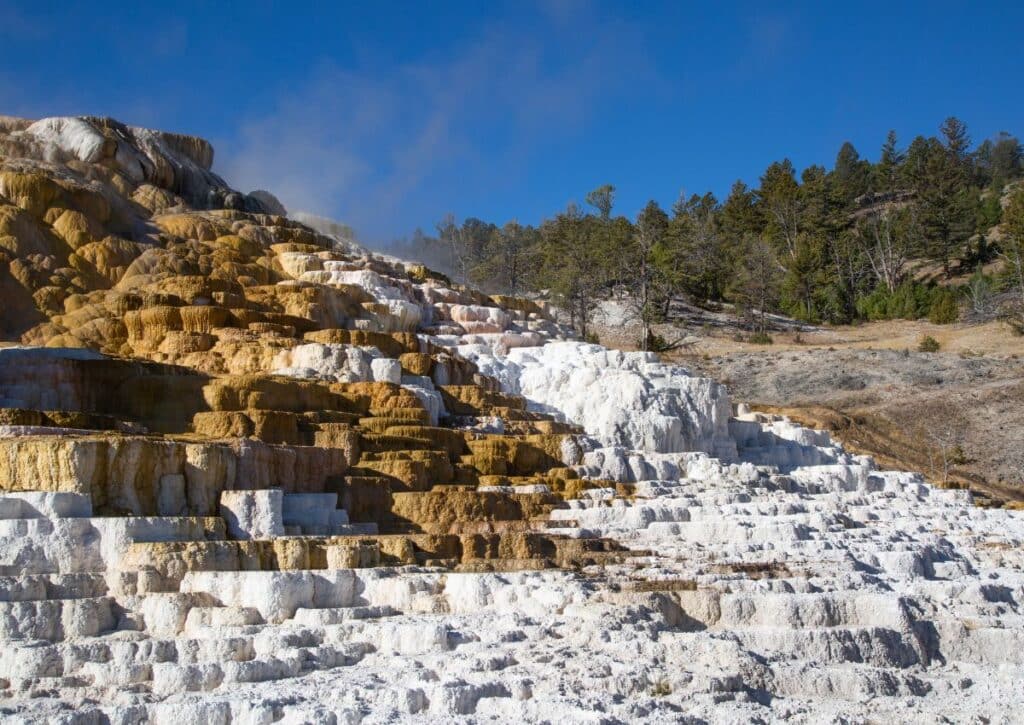
You can access these springs via the Upper and Lower Terraces drive. This 1.75-mile boardwalk loop will guide you through an array of steaming springs, each with its unique color palette thanks to the heat-loving bacteria thriving in this harsh environment. As you meander, keep an eye out for Canary Spring and Minerva Terrace, both known for their striking formations.
One noteworthy feature of Mammoth Hot Springs is its dynamic nature. The springs can change colors and shapes within days due to shifting underground thermal water channels. Some springs might be bone-dry one day and flowing the next. Another interesting fact is that the Mammoth Hot Springs are also the park’s headquarters, and the site of Fort Yellowstone, a former U.S. Army post. Here, you can visit historic buildings, museums, and even spot a herd of elk grazing nearby.
Mammoth Hot Springs is an otherworldly showcase of nature’s creativity, a place where the earth breathes, bubbles, and blooms in ways that can be both gentle and violent. No visit to Yellowstone National Park is complete without experiencing the unique geothermal magic it offers.
West Thumb Geyser Basin
West Thumb Geyser Basin, the largest geyser basin on the shores of Yellowstone Lake, sits on a volcanic caldera within the larger Yellowstone Caldera. It’s located in the southeastern part of the park, along the loop road to Old Faithful.
The basin is accessible via a leisurely boardwalk trail that winds around brilliant hot springs, quaint geysers, and steaming fumaroles. The entire trail is relatively flat and about half a mile in length, making it a straightforward walk for visitors of all ages.
Some of the most famous thermal features you’ll encounter include the Abyss Pool, known for its deep azure blue color and the Fishing Cone, a hot spring right along the lake’s edge.
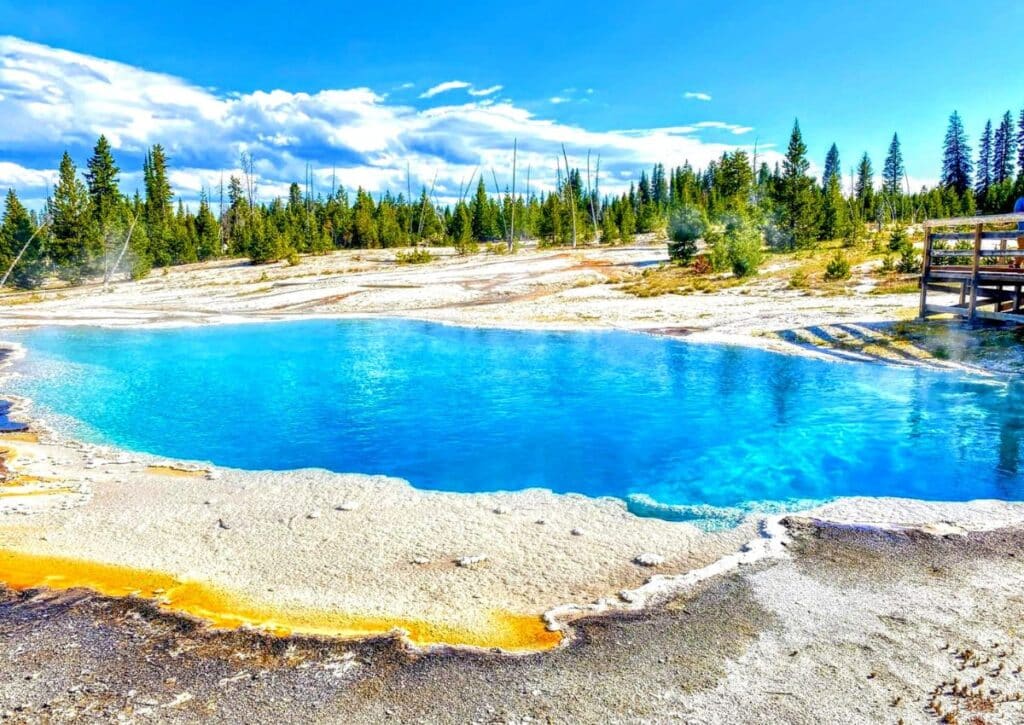
One unique aspect of the West Thumb Geyser Basin is its location by Yellowstone Lake, providing unparalleled vistas. The lake itself is a result of volcanic activity, formed by the same forces that fuel the geysers, hot springs, and mudpots in the park.
As you walk along the trail, you’ll be treated to views of thermal features with the beautiful backdrop of the lake, framed by the Absaroka Mountain Range.
Another fascinating fact about the West Thumb Geyser Basin is its underwater geysers in the lake. These were discovered in the 1990s, forever changing our understanding of the range of Yellowstone’s geothermal features. With its unique landscape and magnificent vistas, the West Thumb Geyser Basin offers a memorable exploration of Yellowstone’s geothermal wonders.
Norris Geyser Basin
Norris Geyser Basin, the oldest, hottest, and most dynamic of Yellowstone’s thermal areas, is situated in the northwestern region of the park. It comprises two distinct areas: the Porcelain Basin and the Back Basin.
The Porcelain Basin offers an otherworldly experience. This area is devoid of vegetation due to the acidic soil conditions and presents a stark, lunar-like landscape full of milky pools, steaming vents, and muddy geysers.
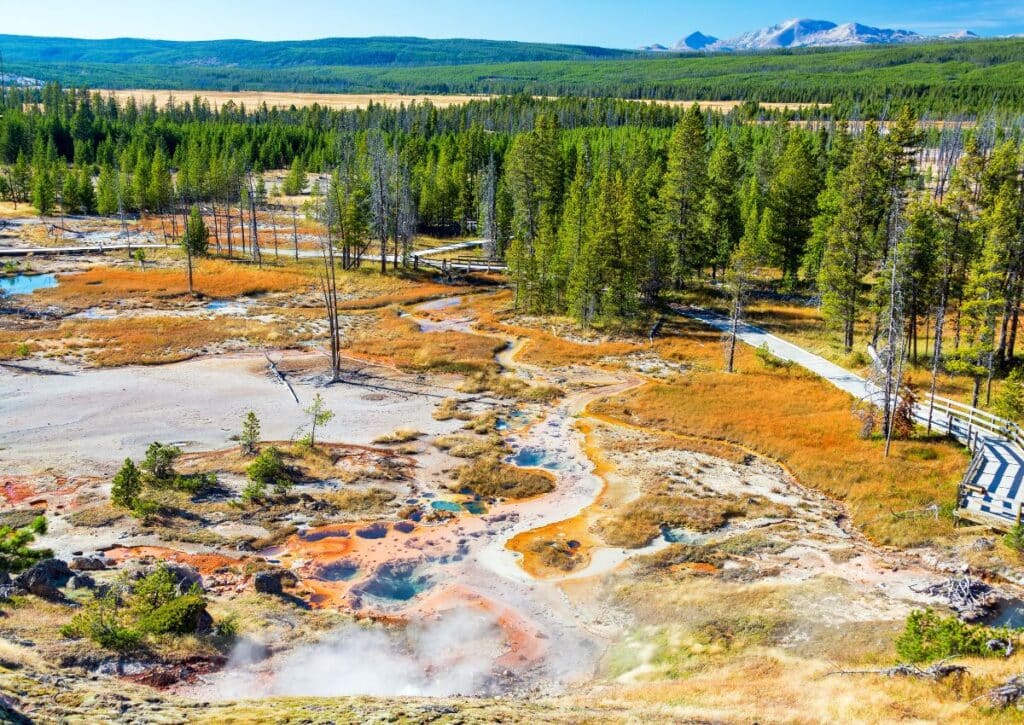
On the other hand, the Back Basin boasts a more forested landscape, dotted with unique features like the Echinus Geyser, famous for its spectacular eruptions.
A couple of miles of boardwalk and trail systems grant access to these natural marvels. Along the way, interpretive signs provide insights into the basin’s volatile geology and the life forms that brave its harsh conditions.
One standout feature in the Norris Geyser Basin is the Steamboat Geyser, the world’s tallest active geyser, capable of blasting water over 300 feet into the air. However, its eruptions are unpredictable, and witnessing an event is a matter of luck.
The Norris Geyser Basin is also notable for its fast-changing nature. New thermal features can appear overnight, and hot springs can quickly turn into geysers or vice versa.
The Norris Geyser Basin provides an intense, dramatic encounter with Yellowstone’s restless volcanic power. This area is a testament to the park’s complex subterranean plumbing system and is a must-visit for any Yellowstone itinerary.
Midway Geyser Basin
Situated between the Upper and Lower Geyser Basins on the west side of Yellowstone National Park, the Midway Geyser Basin may be small in comparison, but it is home to two of the park’s largest hydrothermal features: the Grand Prismatic Spring and the Excelsior Geyser Crater.
The Grand Prismatic Spring, the park’s largest hot spring, is famous worldwide for its striking, rainbow-like coloration that changes seasonally due to variations in bacteria populations.
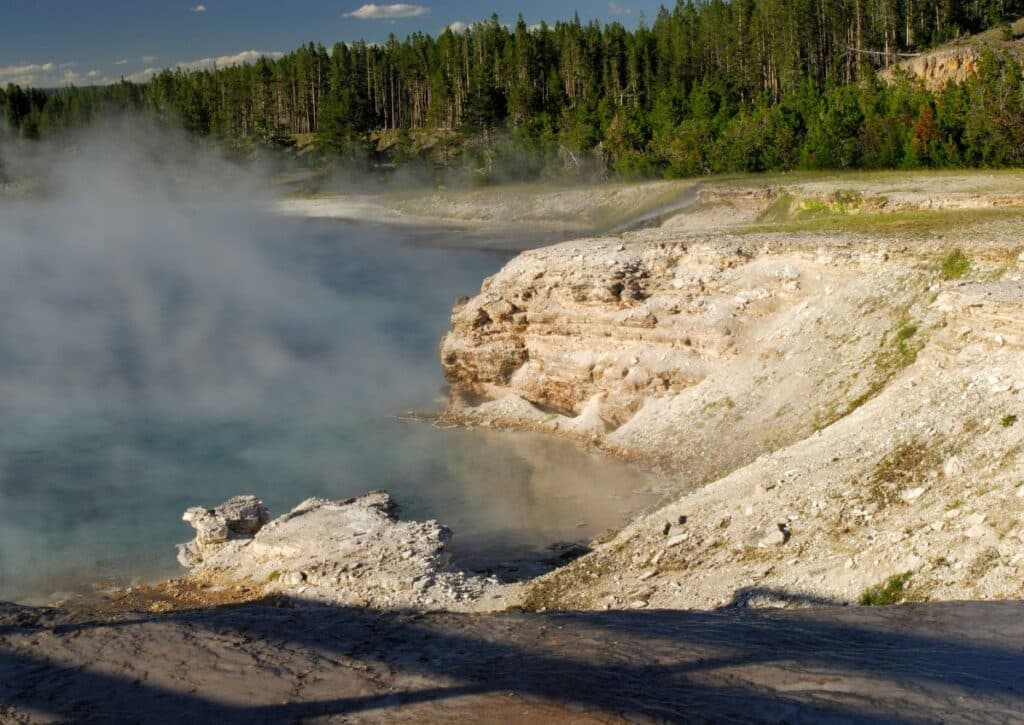
From a nearby overlook, you can marvel at the vivid hues of orange, yellow, and green that ring the deep blue waters, a spectacle unmatched in nature.
Nearby is the Excelsior Geyser Crater, once the largest geyser in the world. Although it’s now mostly dormant as a geyser, it discharges over 4,000 gallons of near-boiling water per minute into the Firehole River, reminding visitors of its former glory.
Access to these stunning features is facilitated by a 0.8-mile boardwalk loop, which includes interpretive displays offering fascinating insights into the basin’s geology. It’s recommended to visit early or late in the day to avoid peak crowd times.
The Midway Geyser Basin offers a unique, accessible experience of Yellowstone’s geothermal majesty. It’s a place where you can see and feel the forces that have shaped the greater Yellowstone ecosystem, right under your feet.
Norris Porcelain Basin
The Norris Porcelain Basin, one half of the expansive Norris Geyser Basin, is nestled in the northwest section of Yellowstone National Park. It’s often considered one of the park’s most striking thermal areas due to its stark, alien-like terrain.
In the Porcelain Basin, the usual dense forest cover of Yellowstone gives way to a barren, white landscape, owing to the mineral-rich waters that flow here. This area got its name from the milky color of the mineral deposits found around the basin.
The barren terrain allows visitors an unobstructed view of the thermal features – hot springs, fumaroles, and geysers, each bubbling and steaming with intense energy.
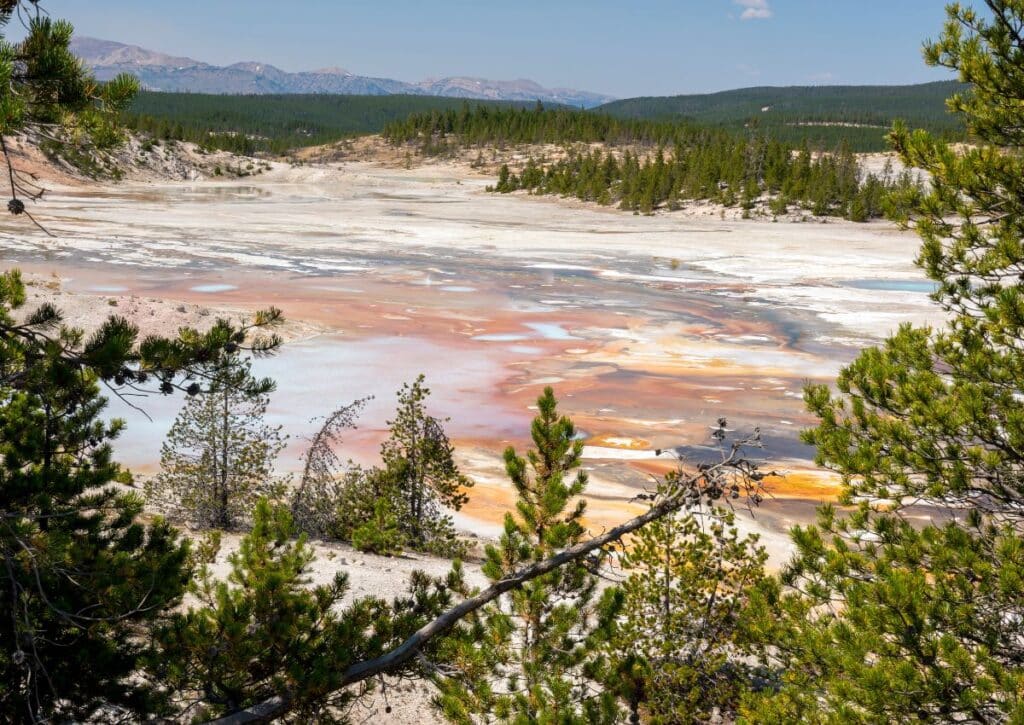
Walking through the 0.75-mile trail looping around the basin provides an up-close experience with this active geothermal area.
Well-placed interpretive signs along the way add to the understanding of the basin’s geology and the adaptations of life forms that thrive here.
One noteworthy fact about the Norris Porcelain Basin is its dynamic nature. The ground here is continually shifting and changing, causing springs to erupt, die out, and then re-emerge, resulting in an ever-evolving landscape.
This fluidity underscores the raw and unpredictable beauty of Yellowstone and provides a window into the forces molding the Earth’s crust. Visiting the Norris Porcelain Basin is like stepping into a natural laboratory, providing insights into the Earth’s inner workings.
Fountain Paint Pot
Located in the Lower Geyser Basin of Yellowstone National Park, the Fountain Paint Pot is a fascinating manifestation of the area’s geothermal activity. It’s conveniently situated just off the Grand Loop Road, making it an easily accessible point of interest.
The Fountain Paint Pot is a mud pot, a kind of hot spring with limited water supply. This leads to the dissolution of surrounding rocks into clay, giving rise to a pool of bubbling mud.
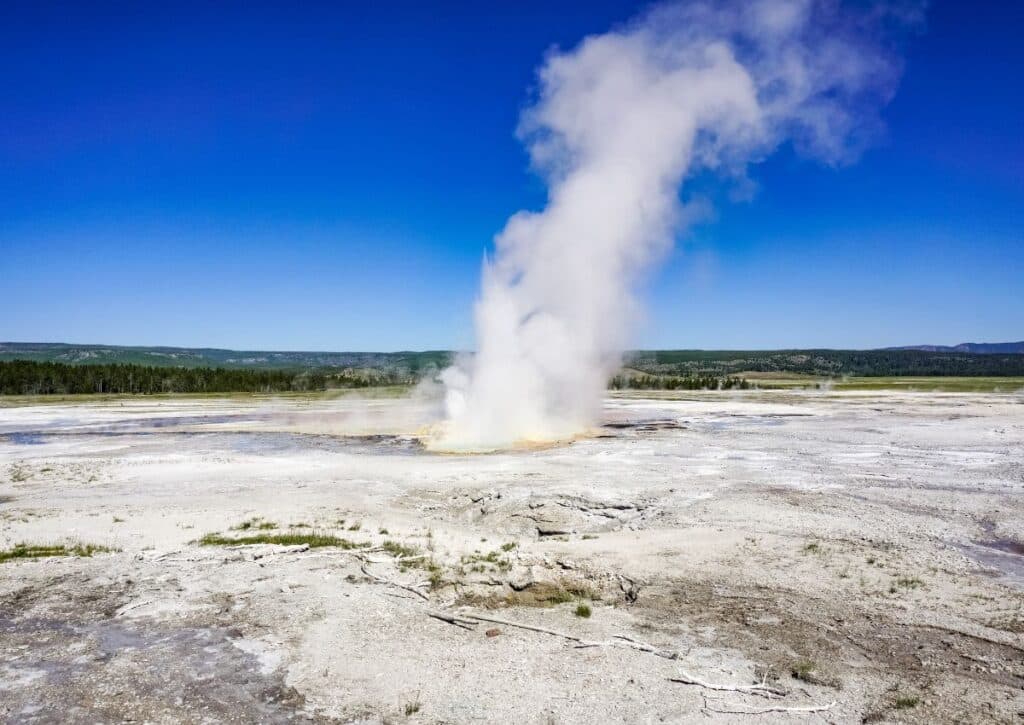
It changes with the seasons, appearing thick and slow-moving in drier periods and more liquid in the rainy months. The mud pot is rich in iron, which oxidizes and gives it an array of colors, from pink to gray.
A 0.5-mile boardwalk loop trail introduces visitors to this area, which not only houses the namesake Fountain Paint Pot but also a variety of other thermal features like the Red Spouter, a fumarole-come-geyser, and geysers like the Fountain Geyser and Clepsydra Geyser.
Clepsydra Geyser is especially intriguing as it erupts nearly constantly, providing a spectacular show for visitors at any time of the day.
The Fountain Paint Pot area represents the full spectrum of geothermal features found in Yellowstone National Park. It serves as a fascinating reminder of the immense heat simmering just below the Earth’s crust in this remarkable region.
Beehive Geyser
The Beehive Geyser, located in the Upper Geyser Basin of Yellowstone National Park, is one of the most powerful and impressive geysers in the park. It sits near Old Faithful and is named for the distinctive, four-foot tall beehive-shaped cone from which it erupts.
When Beehive Geyser erupts, it’s a truly remarkable sight. It can spout a column of water nearly 200 feet into the air, a show that lasts up to five minutes, accompanied by a roaring steam phase that can continue for up to 20 minutes.
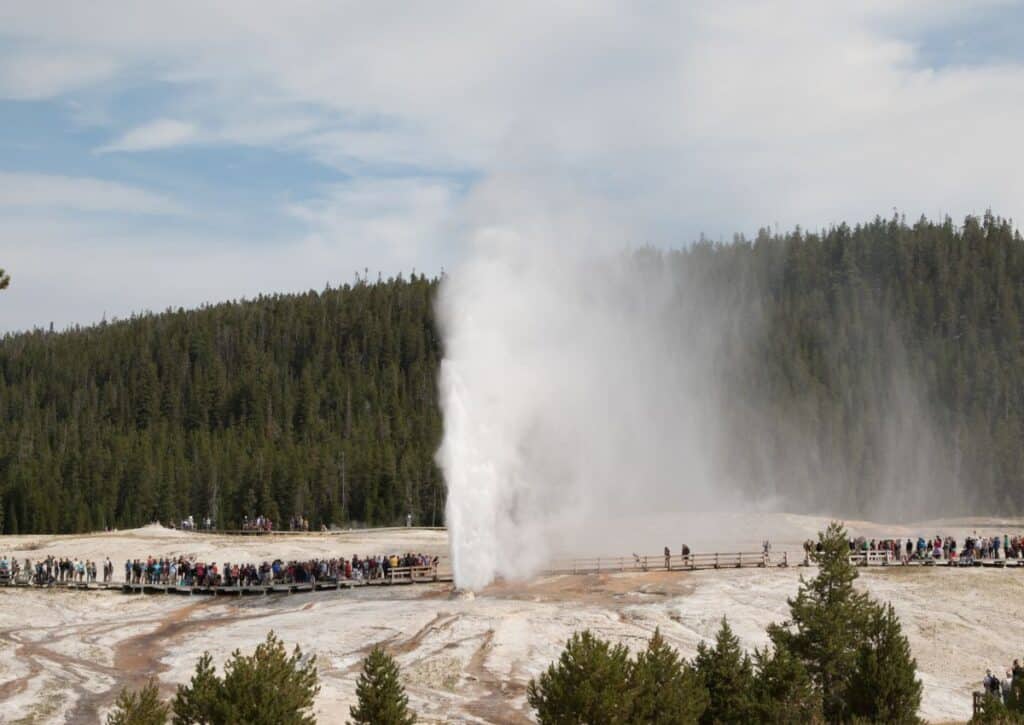
What makes Beehive even more intriguing is the unpredictability of its eruptions, which can occur twice a day or with gaps of up to five days.
Visitors can reach Beehive Geyser by the boardwalk trail that runs through the Upper Geyser Basin, one of the most geothermally active areas in the world.
Just before an eruption, the geyser often gives a warning in the form of “indicator eruptions” from a smaller adjacent geyser.
The Beehive Geyser, with its unique cone and powerful eruptions, provides a memorable spectacle and is another testament to the sheer geothermal energy that lies beneath Yellowstone’s surface. Even if you don’t catch an eruption, the unusual formation of the geyser’s vent is worth a visit.
Terrace Spring
Terrace Spring, located just north of Madison Junction in Yellowstone National Park, is a lesser-known gem offering a serene setting and a glimpse of the park’s impressive geothermal activity.
Despite being less frequented, Terrace Spring holds its own unique allure. Its vibrant hot spring pools nestle within terraced rock formations from which it derives its name. The spring gets its vibrant colors from thermophiles – microorganisms that thrive in the hot water – creating a stunning palette of blues, greens, and oranges.
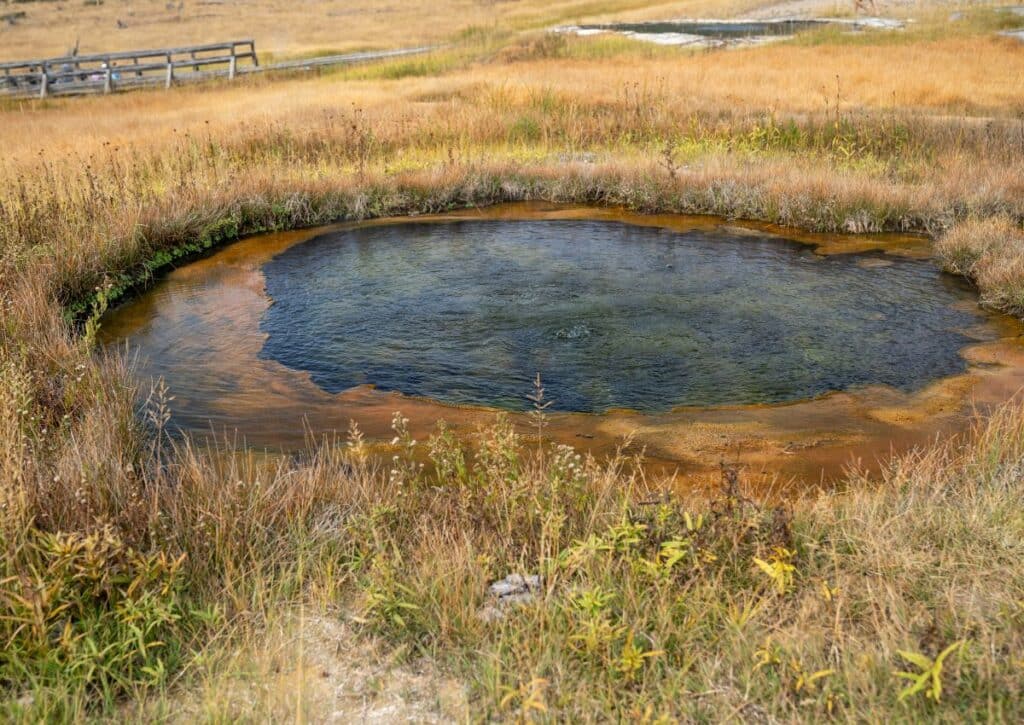
Visitors can access Terrace Spring via a short, easy trail that leads to an overlook. There, you can marvel at the brilliantly colored pools and rising steam, reminding you of the geothermal forces at play beneath the tranquil surface.
In addition to the spring’s natural beauty, it’s also a great spot for wildlife viewing. Given its less crowded nature, animals like elk and bison can often be spotted in the vicinity. Remember, always view wildlife from a safe distance.
Terrace Spring offers a more peaceful alternative to some of the park’s bustling hotspots, making it a worthwhile detour for those seeking both geothermal wonders and a bit of tranquility.
Black Sand Basin
Black Sand Basin, situated in the Upper Geyser Basin of Yellowstone National Park, is an isolated thermal area that offers an intimate and awe-inspiring experience. The basin gets its name from the small fragments of black obsidian sand found in the area.
Upon visiting Black Sand Basin, you’re met with a variety of geothermal features including hot springs, geysers, and fumaroles. Rainbow Pool, with its deep blue center and fringes of bright orange and green, is particularly eye-catching, while the energetic Cliff Geyser provides regular eruptions from its location on the banks of Iron Creek.
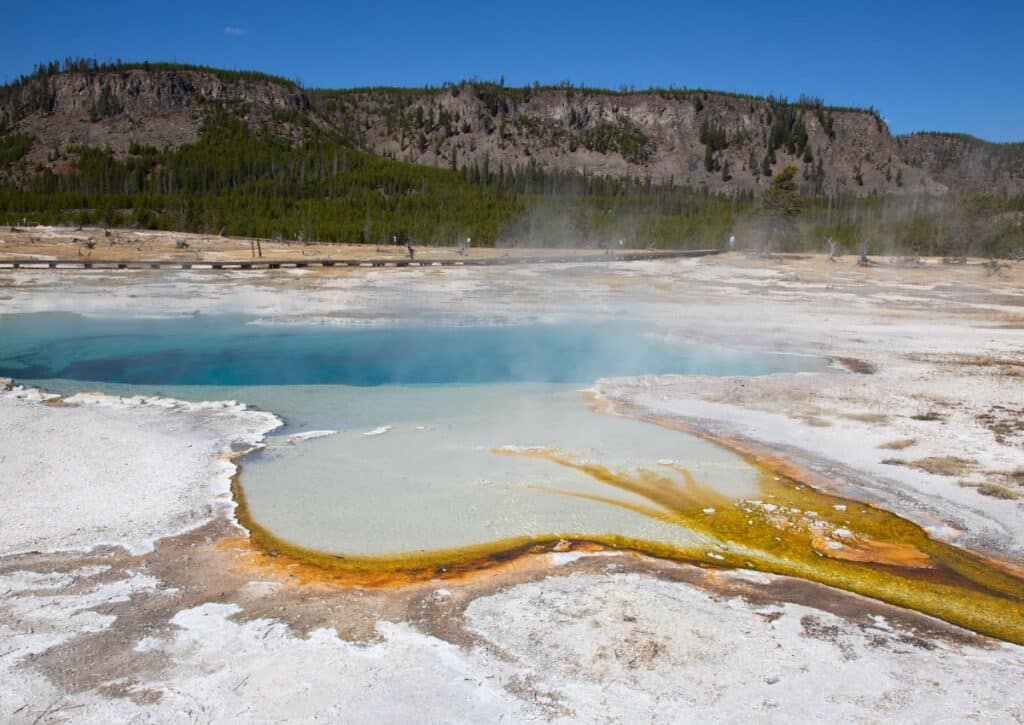
A well-maintained boardwalk allows visitors to meander safely amongst the steaming pools and geysers. Throughout the 0.4-mile loop, interpretive signs provide insights into the dynamic geology beneath your feet.
Notably, Black Sand Basin was not always an isolated region. Before the 1959 Hebgen Lake earthquake changed the area’s hydrothermal dynamics, it was part of the larger Sunset Lake. Today, the basin offers a quieter alternative to some of Yellowstone’s more trafficked areas, without compromising on the park’s geothermal splendor.
Whether it’s the otherworldly colors of the pools, the power of the erupting geysers, or the tranquility of this less-visited area, Black Sand Basin leaves an indelible impression on its visitors.
Steamboat Geyser
Steamboat Geyser, located in Yellowstone National Park’s Norris Geyser Basin, holds the title of being the world’s tallest currently-active geyser. Known for its spectacular and somewhat unpredictable eruptions, Steamboat can spew water over 300 feet into the air, almost three times the average height of an Old Faithful eruption.
Despite its impressive capabilities, Steamboat Geyser does not follow a predictable eruption schedule like Old Faithful. Major eruptions can occur anywhere from a few days to several months apart. These dramatic displays, lasting from a few minutes to more than an hour, are followed by powerful jets of steam.
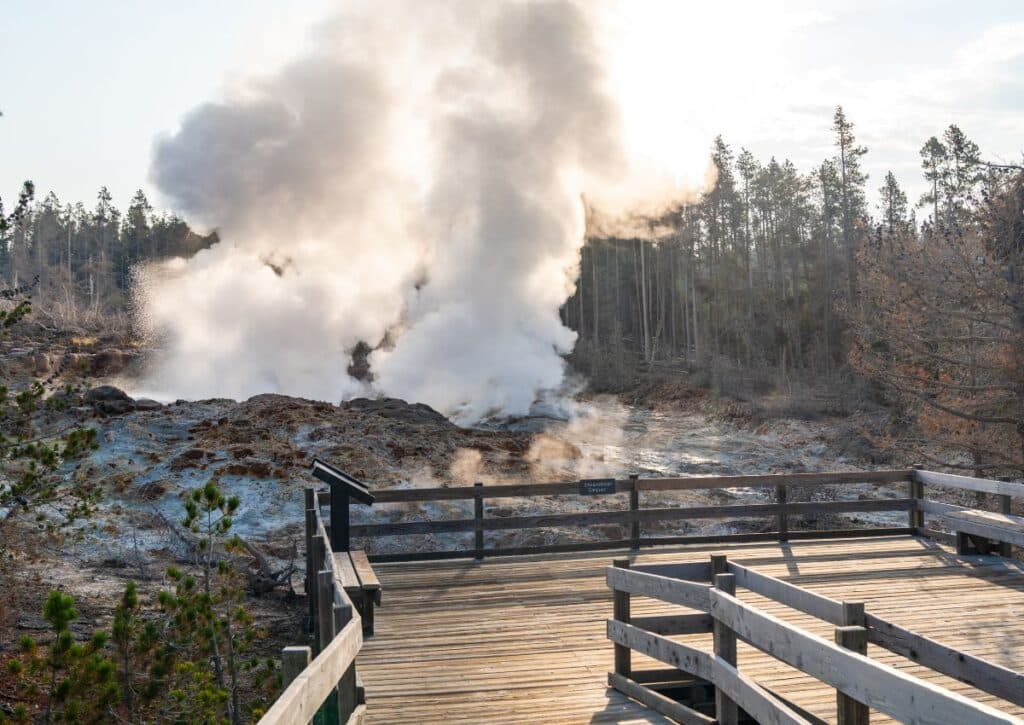
The area surrounding the geyser, known as the Back Basin, can be accessed via a series of trails and boardwalks that meander through the geothermally active region. Along the way, interpretive signs provide insightful information about the basin’s geothermal activity.
Apart from its geological fascination, Steamboat Geyser’s location also provides an opportunity for spotting wildlife, including the park’s diverse bird species. Remember, though, always to enjoy from a safe distance.
The raw power and unpredictability of Steamboat Geyser make it a must-visit spot in Yellowstone. Witnessing an eruption is a memorable experience, reminding visitors of the immense geothermal energy simmering beneath the surface of the park.
Grand Geyser
Grand Geyser, situated in the Upper Geyser Basin of Yellowstone National Park, is hailed as the tallest predictable geyser in the world. It shares a thermal network with two other geysers – Turban and Vent – which all together make up the “Grand Group.”
Grand Geyser regularly awes visitors with its spectacular eruptions, which reach heights of up to 200 feet and can last from 9 to 12 minutes. Unlike some of its unpredictable counterparts in the park, Grand Geyser erupts approximately every 7 to 15 hours, offering reliable displays of geothermal might.
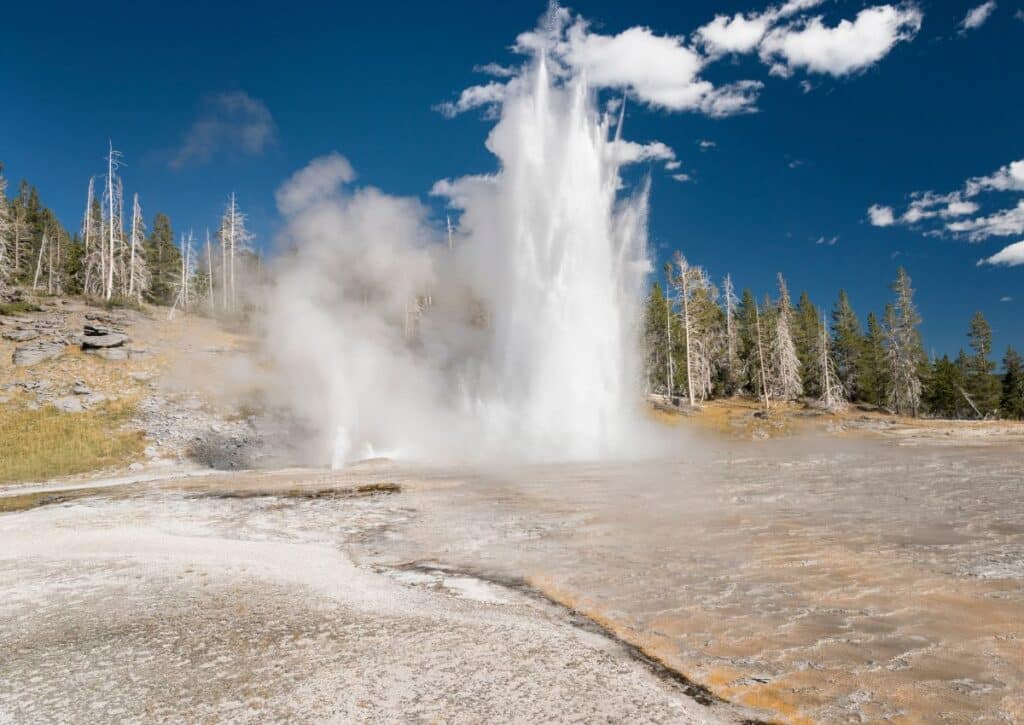
A network of boardwalks leads visitors to Grand Geyser from the Old Faithful area, winding through the geothermally rich basin. As you walk, interpretive signs provide context and interesting information about the basin’s thermal features.
In addition to its powerful eruptions, Grand Geyser is noted for the stunning rainbow that often forms in its mist on sunny days. With its predictability and grandeur, Grand Geyser truly lives up to its name, offering visitors an unforgettable display of Yellowstone’s dynamic geology.
Sapphire Pool
Located in the Biscuit Basin section of Yellowstone’s Upper Geyser Basin, Sapphire Pool is famed for its stunningly clear, turquoise waters. Named for its jewel-like blue coloration, reminiscent of a sapphire gemstone, the pool showcases the beauty of Yellowstone’s thermal features.
The depth and clarity of Sapphire Pool create an ethereal sight, with intense azure waters framed by a white mineral crust. However, this serene body of water was once a violent geyser.
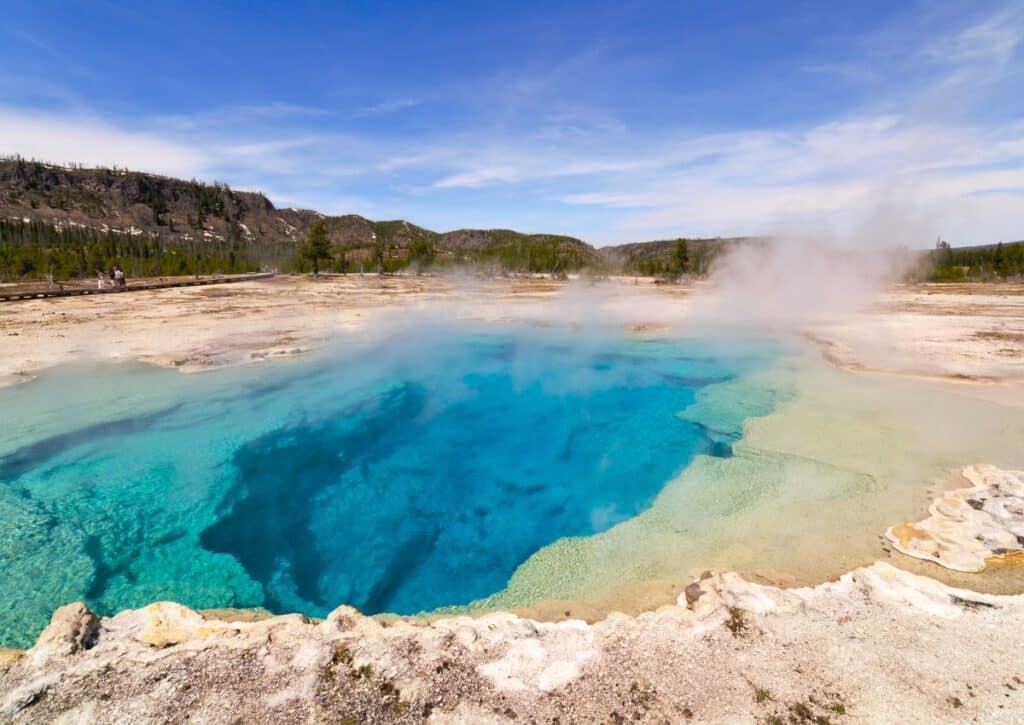
Following an earthquake in 1959, Sapphire Pool became a powerful geyser, erupting regularly until the early 1960s when its behavior subsided to the placid pool we see today.
Visitors can reach Sapphire Pool via an easy 0.6-mile boardwalk loop trail that winds through Biscuit Basin. Along the trail, interpretive signage provides insights into the area’s geothermal activity and the park’s unique thermal ecology.
While not a geyser in the present day, Sapphire Pool remains a remarkable sight. Its brilliant hue, serene demeanor, and historic explosiveness make it a fascinating stop in any tour of Yellowstone’s geothermal wonders.
Lone Star Geyser
Lone Star Geyser, a cone-type geyser located about five miles southeast of Old Faithful in Yellowstone National Park, is a geothermal treasure often overlooked due to its somewhat remote location.
Named for its isolated position and impressive eruptions, Lone Star Geyser offers a less crowded and serene geothermal viewing experience.
The geyser’s cone, encrusted with layers of siliceous sinter deposited over countless eruptions, adds to its distinct appearance. Eruptions, reaching up to 45 feet high, occur approximately every three hours, lasting around 30 minutes and followed by a noisy steam phase.
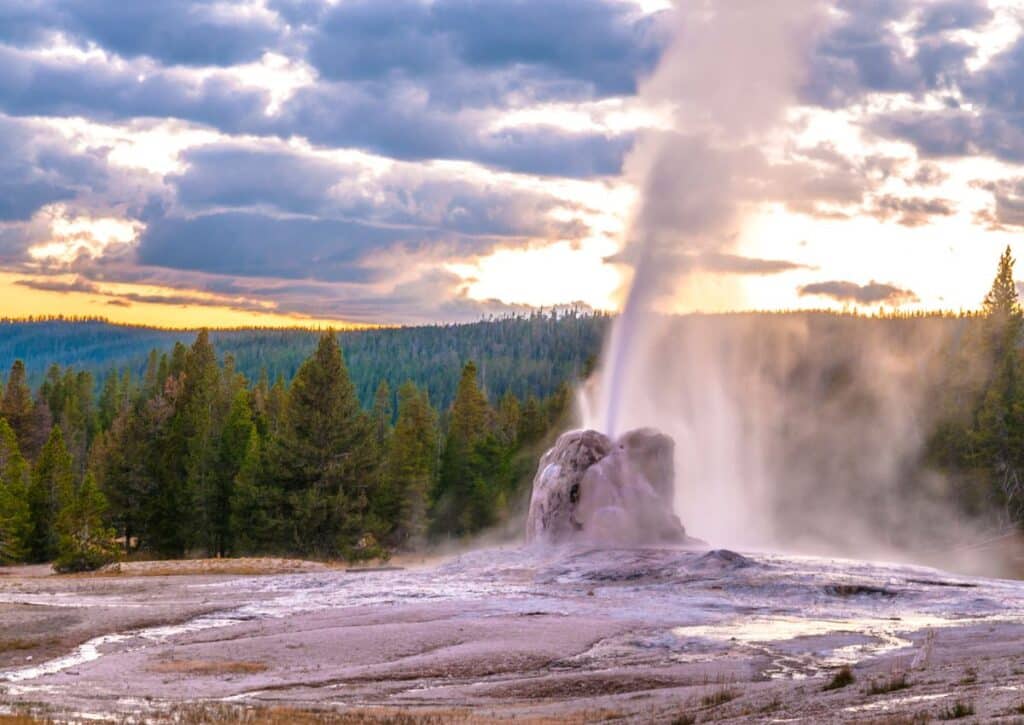
Visitors can access Lone Star Geyser via an old service road, now a 4.8-mile round trip trail that follows the Firehole River. It’s a peaceful and scenic walk, punctuated by wildflowers in summer and changing leaves in fall.
Lone Star Geyser exemplifies the park’s dynamic geothermal activity. Its isolated location and the easy, beautiful trail leading to it make it a cherished destination for those seeking a more tranquil geyser-viewing experience.
As with all thermal features, remember to stay on the trail for safety and respect this unique natural spectacle.
Daisy Geyser
Situated along the Upper Geyser Basin’s southern boardwalk loop, Daisy Geyser is an active and predictable cone-type geyser in Yellowstone National Park. It’s a less famous counterpart to the nearby Old Faithful, but offers its own unique charm and draws a dedicated crowd of geyser enthusiasts.
Daisy Geyser erupts with delightful regularity, approximately every two to four hours. Its eruptions reach heights of 75 feet and last about 3 to 5 minutes, spraying streams of water and steam in a fan-like shape that inspired its name.
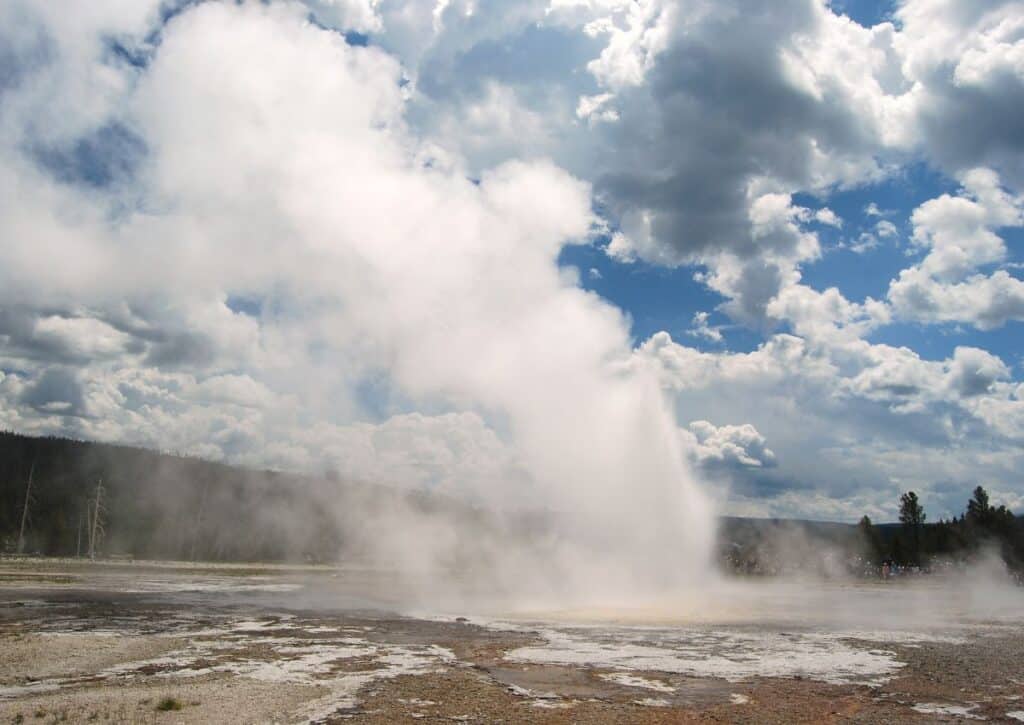
Visitors can reach Daisy Geyser by following the boardwalk loop from the Old Faithful Visitor Center, passing by a host of other active geysers and hot springs along the way. Keep an eye out for the interpretive signs that provide valuable insights into the park’s geothermal phenomena.
Apart from its predictable eruptions, Daisy Geyser is also known for the stunning contrast it forms against the clear Wyoming sky, especially during sunrise and sunset. A visit to this less crowded yet equally fascinating geyser adds a layer of depth to any Yellowstone adventure.
Colorful Palette of Yellowstone’s Hot Springs
One of the captivating aspects of exploring Yellowstone’s hot springs is the mesmerizing array of colors on display. These colors aren’t mere spectacle; they’re the result of a fascinating interplay between Yellowstone’s geothermal activity and an array of microscopic organisms.
The palette starts with the intense blues at the heart of the pools. This is a result of the water’s absorption of sunlight. Water molecules absorb light in the red part of the spectrum, and the shorter-wavelength blue light gets scattered and reflected back to our eyes, creating the deep azure we perceive.
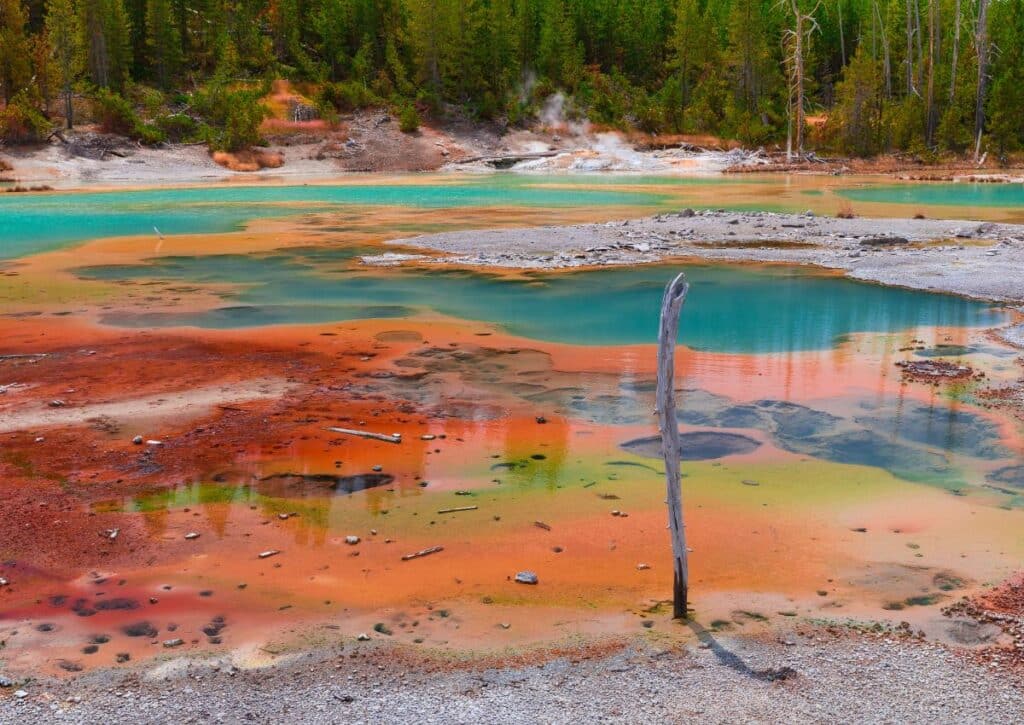
As we move outward from the center of the springs, the colors shift. Yellows, greens, and oranges come into play, reflecting a change in temperature. These colors are the work of thermophilic (heat-loving) bacteria and archaea, which form microbial mats.
Each species thrives at a specific temperature range. For instance, cyanobacteria, giving off a lush green color, flourish in slightly cooler regions compared to those at the hot center.
The most spectacular display may come from the outermost regions of the springs, where temperatures are cool enough to support vast communities of extremophiles. Here, orange, red, and brown mats form, a testament to the diversity of life under extreme conditions.
This vibrant, living tapestry changes with the seasons and over time, as the microbial communities respond to shifts in the geothermal flux beneath them.
It’s a beautiful demonstration of life’s tenacity, a vivid sign of the park’s geothermal vitality, and an unforgettable sight for visitors. Yellowstone’s hot springs, thus, serve as windows into both the Earth’s fiery underbelly and the adaptability of life itself.
Yellowstone’s Thermophiles
Awe-inspiring and scientifically significant, Yellowstone’s hot springs are home to a multitude of life forms that not only survive but thrive in extreme heat – the thermophiles.
These microscopic organisms have evolved to live in temperatures that would be lethal to most other forms of life, making Yellowstone’s geothermal pools a living laboratory for the study of life’s resilience and adaptability.
Thermophiles come in diverse forms – bacteria, archaea, and even some types of algae – and each species has its preferred range of temperature and pH. Some favor the relatively balmy waters around the springs’ edges, while others inhabit the scorching depths near the springs’ heat sources. Together, they form vibrant microbial mats that paint the springs’ terraces with their striking hues.
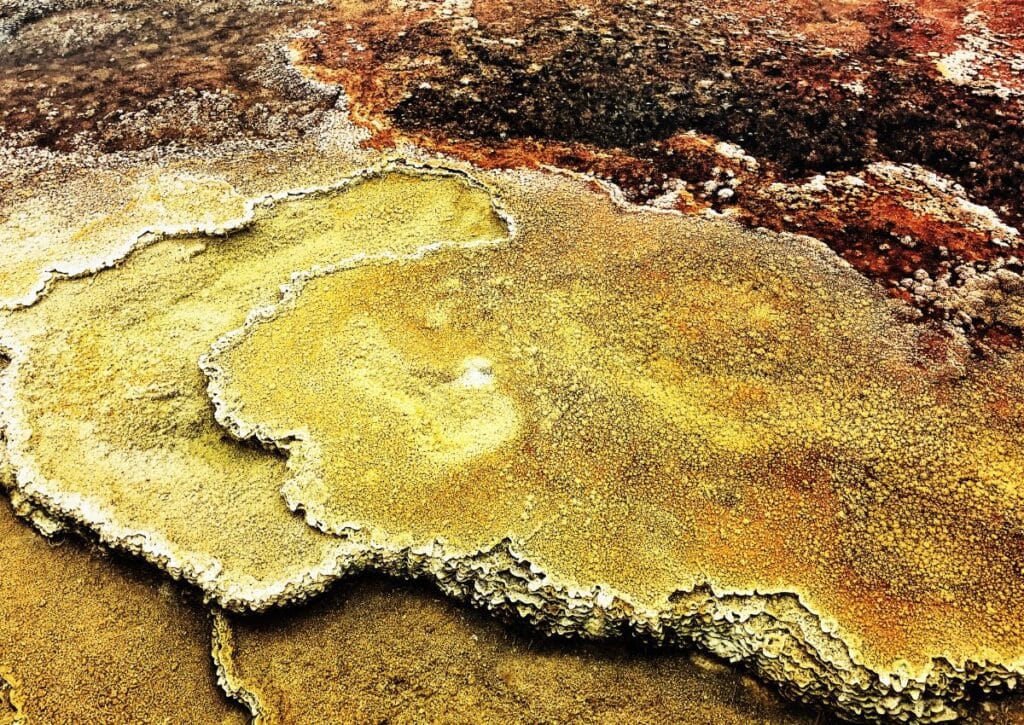
But the importance of thermophiles extends far beyond their aesthetic contribution. They’re biological marvels, and the secrets of their survival mechanisms are of great interest to scientists.
Their unique enzymes that operate at high temperatures have proved invaluable in a range of applications, including disease research, biofuel production, and even laundry detergents.
Thermophiles have also expanded our understanding of life’s potential habitats, including extreme environments on Earth and potentially other planets.
As astrobiologists study the conditions in which life can exist, the thermophiles of Yellowstone provide a model for life’s potential beyond Earth.
So, when you gaze upon Yellowstone’s hot springs, remember: you’re witnessing a world within a world, one where life has carved out a niche in the harshest of environments, unveiling both the power of adaptation and the vast potential of life’s diversity.
Tips and Safety Measures
Exploring Yellowstone’s hot springs can be an enchanting experience. However, it’s essential to adhere to guidelines for both your safety and the preservation of these natural wonders. First, always stay on the boardwalks and trails; the crust around hot springs can be fragile and thin, hiding scalding water beneath.
Never attempt to touch the water or throw objects into the springs, as this can cause injury and disrupt the delicate ecosystems within. Remember, many of the organisms that paint the springs’ colors are sensitive to changes in their environment.
Also, wildlife in the park should be observed from a distance. Do not feed or approach animals. Maintain a distance of at least 100 yards from bears and wolves, and 25 yards from other animals.
The ethos of national parks: take only photographs, leave only footprints. Together, we can ensure these geological marvels continue to captivate future generations.
Firehole River Swimming Area
Yellowstone National Park, renowned for its geothermal features, also offers visitors unique swimming experiences, as long as you know where to look. While most hot springs and geysers are far too hot for safe swimming, there are a few areas where you can take a dip.
The Firehole River Swimming Area is one such spot. Located on Firehole Canyon Drive, the swimming area is an oasis of refreshing, heated waters. Carved through rhyolite rock, this spot is a blend of cooler river water and warmer geothermal water, providing a delightful bathing experience in a strikingly scenic setting.
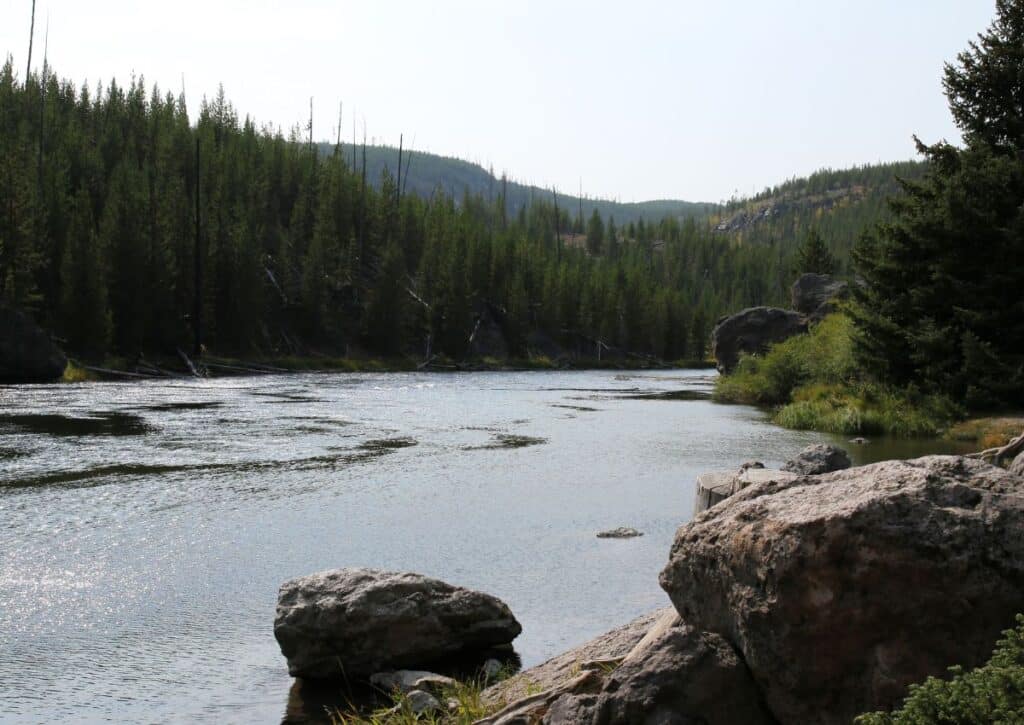
Apart from Firehole, the Boiling River near Mammoth Hot Springs is another popular spot. It’s one of the few places where park visitors can soak in the naturally heated waters. The Boiling River Trail is roughly a half-mile from the parking area to the soak zone where the hot and cold waters mix.
However, ensure that you follow all safety guidelines and respect closures, which can occur due to high water, bad weather, or wildlife activity. These natural swimming spots are treasures of Yellowstone and deserve our care and respect.
Conclusion
Yellowstone National Park, a realm of geothermal wonders, invites you to embark on an adventure like no other.
From the hypnotic eruptions of Old Faithful to the breathtaking palette of the Grand Prismatic Spring, and the remarkable biodiversity thriving in extreme conditions, Yellowstone’s hot springs are nothing short of nature’s grand spectacle.
The ever-changing landscapes of the park, shaped by these thermal features, truly encapsulate the dynamic nature of our planet.
In addition, the rare chance to swim in naturally heated waters at spots like the Firehole River Swimming Area is an experience that combines recreation with awe-inspiring nature.
The steaming waters, the vibrant microbial mats, and the rich ecology offer valuable insights into life’s adaptability and the extraordinary beauty of our natural world.
As we revel in these wonders, let’s not forget our responsibility. These treasures are our shared heritage and require our collective commitment to their preservation.
So, whether you’re planning a visit or learning from afar, remember to respect and protect these marvels. Let’s ensure that the magic of Yellowstone’s hot springs continues to inspire curiosity, discovery, and reverence for nature in generations to come.

